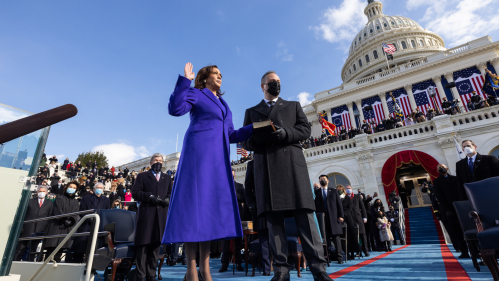A Center for American Women and Politics report outlines the status of Black women and provides an outlook for the midterm elections
Kamala Harris made history in 2020 when she became not only the first woman, but the first Black and South Asian woman, to be elected to a federal office: Vice President of the United States.
But her victory also had a downside for representation in the U.S. Senate. Harris had to give up her seat representing California, leaving no Black women serving in the chamber.
Although Black women have made significant advances in politics in the last few years – and ran for and won congressional offices in record numbers – they remain underrepresented at the state and national levels, said Kelly Dittmar, a scholar and director of research at the Center for American Women and Politics (CAWP) and associate professor of political science at Rutgers University-Camden.
No Black women have ever held the office of governor and are currently absent from the Senate, according to a recently released report Dittmar coauthored with Higher Heights Leadership Fund, a national organization building the political power and leadership of Black women. “Reaching Higher: Black Women in American Politics” outlines the status of Black women in American politics as of fall 2021 and provides an outlook for the 2022 election.
Black women’s state legislative representation did increase between 2020 and 2021, Dittmar said, though not as much as it did after the 2018 election. While the number of Black women candidates who ran for office reached an all-time high in 2020, with 117 Black women running for U.S. House seats, gains at the polls were more modest. That’s because they ran almost entirely as Democrats in a year that ended up being especially good for Republicans, she said.
Remaining biases about Black women’s ability to win statewide and in majority white electorates also contribute to their underrepresentation, said Dittmar.
“The earliest gains in Black women’s political representation were in majority minority districts. That pattern could lead the folks with political influence – historically predominantly white men – to make assumptions that that’s where they win,” she said.
“Black women haven’t been recruited and supported in majority white districts to the same degree as their white counterparts. When we do see them run there, they do win,” Dittmar said.
She points to Stacey Abrams’s near success in her 2018 Georgia gubernatorial run – despite her challenger, then Georgia secretary of state Brian Kemp, purging 340,000 from the state’s voter rolls. Abrams’s strong run, said Dittmar, effectively chipped away at this long-standing bias about Black women’s electability outside of minority majority districts.
“Georgia is a state where there is racial division and distinct communities assumed to be more reluctant to vote for Black candidates,” she said. “Abrams pushed back against those fears.”
For this year’s midterms, Dittmar said a slate of uniquely qualified Black women – Abrams, U.S. Senate candidates Cheri Beasley of North Carolina, a Rutgers alumna who graduated from Douglass College and was the first Black Chief Justice of North Carolina’s Supreme Court, and U.S. Representative Val Demings of Florida among them – are poised to further challenge that bias.
“Even if they don’t win, they are running very competitive campaigns and can start to normalize the presence of Black women candidates at the highest level of American politics,” she said.
Gerrymandering and legislation that restricts voting rights – from voter ID requirements to polling station closings and laws barring volunteers from providing food and water to voters stuck on long poll lines – present another set of challenges for Black women candidates in the midterm, said Dittmar, primarily because of the disproportionate effect of these barriers on Black voters.
“This is the history of voter suppression. You’re not saying you can’t vote. You are just making it incredibly hard to do so,” said Dittmar. “There is significant scholarship showing these sorts of restrictions have distinct effects on racial and ethnic minority communities. And since 80 percent of Black voters are Democrats, it does have a partisan effect. If you try to dilute that vote, it is not surprising that it would affect Black women – particularly Democratic Black women’s candidacies and success.”
Advocates and candidates alike have worked for eight years, through a pandemic, fighting against voter suppression and racial and gender bias, and calling out threats of violence that Black women candidates and officeholders disproportionately face. The question that looms as midterms approach, said Dittmar, is whether they will be able to maintain that level of enthusiasm they need to succeed. And will their white counterparts contribute in real and meaningful ways to their efforts?
“What is on us as a society is to make good on the promises that we have tweeted out and spoken out on in the last few years regarding a commitment to equity and representation and gratitude for Black women’s century-plus of efforts to strengthen our democracy,” said Dittmar. “There is a lot of talk about thanking Black women and listening to Black women. Now we need to make good on that by supporting Black women who are running for office with our vote, our time or our money."



